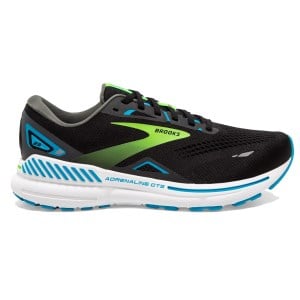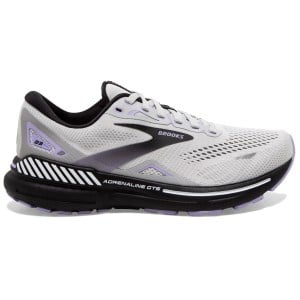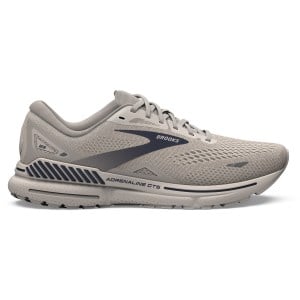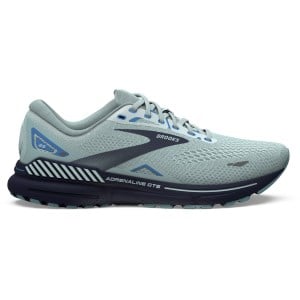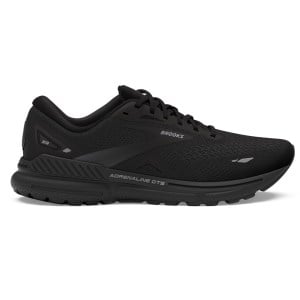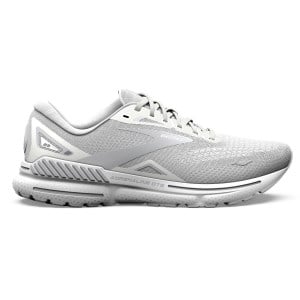Brooks Adrenaline GTS 23 vs 22 Comparison Running Shoe Review
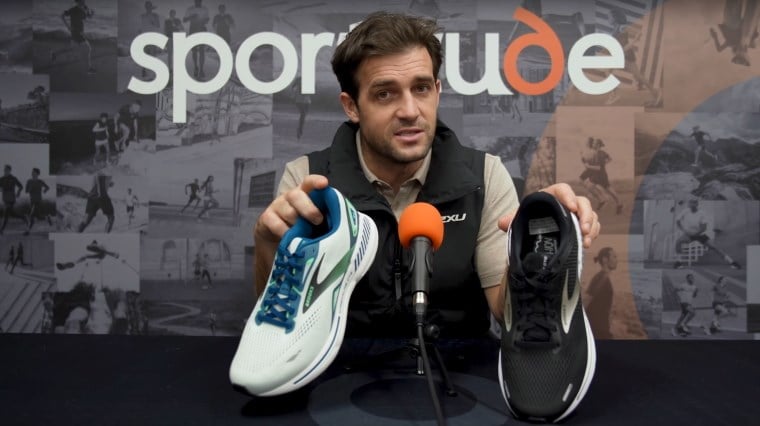
The main difference between the Brooks Adrenaline GTS 23 running shoes and the Brooks Adrenaline GTS 22 running shoes is that the Brooks Adrenaline GTS 23 feature extra memory foam at the heel counter for an improved, foot-hugging fit and softer cushioning with DNA Loft v2 technology.
Consistency and reliability are two words that are strongly associated with the Brooks Adrenaline franchise - so loyal runners of this running shoe family will be happy to know that not a lot has changed.
Brooks have stuck with what works to provide a heel striker and overpronator-friendly ride - offering stability with their trusted GuideRails support system.
Slightly more outsole coverage with varying densities of rubber offers protection for the responsive and plush (but not too plush) DNA Loft v2 midsole. These engineering improvements extend the lifespan of your go-to running shoes while offering versatility and balanced cushioning for everything from longer runs to the occasional speedwork session.
Check out the review with full transcript below.
-
Brooks Adrenaline GTS 23 - Mens Running Shoes
-
Brooks Adrenaline GTS 23 - Mens Running Shoes
-
Brooks Adrenaline GTS 23 - Womens Running Shoes
Hey guys, Josh here from Sportitude Running. It’s shoe review time and we're going to be talking all things Brooks Adrenaline GTS 23. This running shoe has just landed in the mid-part of June 2023 and it’s an exciting update for a very reliable, honest and consistent performer. This will be a comparison review with the Brooks Adrenaline GTS 22.
In today's review we will cover the outsole, midsole and the upper. There are marginal changes in all three of those engineering categories which we'll dive into in today's review. We'll give you all the information you need at home to potentially make this your next running shoe purchase.
Without further ado let's get stuck in.
What Foot Type Should Consider The Brooks Adrenaline GTS 23?
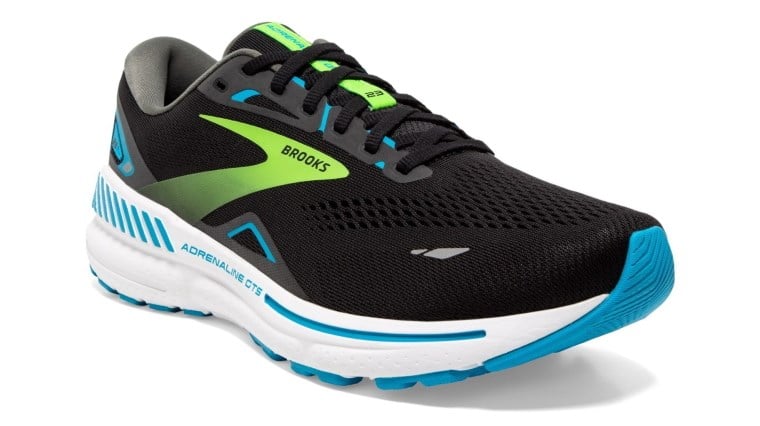
Before we dive in, we want to highlight that this running shoe is engineered and designed for the mild overpronator. An overpronator refers to someone who has a slightly flatter arch.
As they transition through their gait cycle, whether landing on heel first, midfoot first or even forefoot first through the midstance phase, they have a tendency to favour that medial side, rolling over the arch. The strategically placed GuideRails in the Brooks Adrenaline GTS 23 offer an element of support and protection for that mild overpronator.
This is a cushioned running shoe, it's not a max cushioned shoe in this category. The Brooks Glycerin GTS franchise is for that runner looking for a little bit more underneath the foot.
We categorise the Brooks Adrenaline GTS 23 into the balanced cushioned category. There is an element of protection but it has a consistent feel right through the performance of the midsole and forefoot. It gives you more response out of the gait cycle due to the DNA Loft v2 technology on offer.
As we described, this running shoe has some cushioning but the performance of this midsole is more about balance and stability throughout the entire gait cycle. It isn't marshmallow-soft underneath the foot, you wouldn't want that from a running shoe like this.
What you want with the Brooks Adrenaline franchise is the protection that you require, and the ability to stay on top of that midsole as you transition through your gait cycle.
In terms of where it fits into your shoe rotation, it is a workhorse. It's a running shoe that's going to allow you to get on the road and push those kilometres. However, the fact that it's not crazy soft underneath the foot can cater for someone who's looking to pick up the pace during longer runs, or you could potentially use it for some speed workouts.
It isn't the lightest shoe in that category, but by no means is it the heaviest either which is a good thing. It has a lot of versatility for your training out on the road. However, the main thing is the GuideRails technology, providing mild overpronators with the support and protection they require.
Outsole
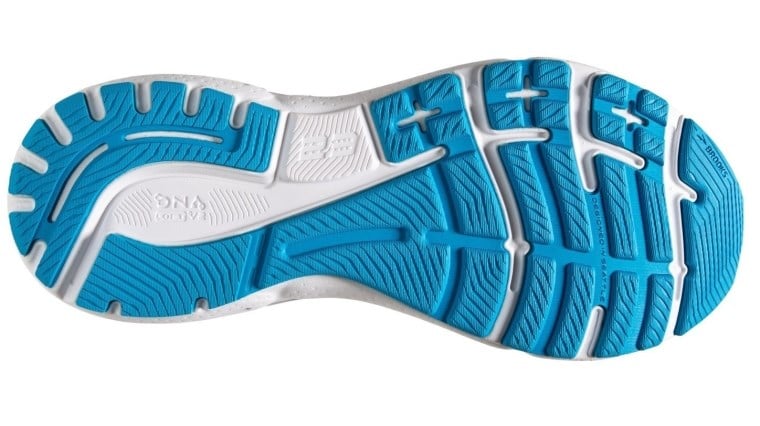
Let's jump into the fun part of today's review and talk all things technology. Let's jump to the outsole first because there’s a bit of change on offer from the Brooks running family.
There are three compounds of rubber on use with the Brooks Adrenaline GTS 23. At the back on that lateral component, we have a harder more abrasive wearing rubber. The main reason it's been strategically placed there is for heel strikers when making contact with the ground. You want an element of hardier rubber which is going to protect the asset, being the midsole.
The midsection of this running shoe is where we used to have the Trusstic system going back a decade or two now. However, Brooks are now using their Green Rubber technology. It isn't quite as aggressive as the lateral component of the heel, but it is their take on the environmentally friendly rubber which they're using in a lot of Brooks running shoes.
It is a really stable rubber. It plays a strategic part in the overall engineering of the running shoe. We used to see plastic Trusstic systems on offer, but now full ground coverage is very popular with nearly every single brand.
Using a good, hardy rubber in that midsection provides the element of support you need. You can see a little bit of exposed DNA Loft v2 cushioning system. I'm going to try and articulate why they have done that.
When you're transitioning from your heel strike zone to your midstance zone, this exposed area of midsole will compress more on the lateral side. This aids in the protection of the medial side of this running shoe and works in unison with the GuideRails for overpronators to help provide support.
As you come through to the forefoot, we have the blown rubber technology. Blown rubber is a softer, spongier rubber in comparison to the other two compounds. Holding the Brooks Adrenaline GTS 22 and Brooks Adrenaline GTS 23 up side by side, it is very hard to see the difference. However, because the DNA Loft v2 cushioning system is slightly softer in the Brooks Adrenaline GTS 23, they have a little bit more coverage underneath regarding the rubber on offer in comparison to the Brooks Adrenaline GTS 22.
It is very hard to see. We have 5 rubber units on offer with the Brooks Adrenaline GTS 22 and 4 rubber units on offer regarding the coverage of the Brooks Adrenaline GTS 23 for a little bit more protection underneath the outsole.
Upper

Let's jump straight to the top and talk all things upper. Brooks for a number of years now have been incredibly good at executing fantastic uppers. What we have on offer in comparison from the Brooks Adrenaline GTS 23 to the Brooks Adrenaline GTS 22 is not a whole lot of change. That's a consistent theme regarding every engineering component of this running shoe.
Let's talk about the mild changes with the Brooks Adrenaline GTS 23. Brooks have executed the internal heel collar in nearly every one of their running shoes exceptionally well over the last decade. The Brooks Adrenaline GTS 23 in comparison to the Brooks Adrenaline GTS 22 has a little bit more memory foam on offer.
Improving that first fit, feel and overall comfort is obviously a key factor with uppers. Having a little bit more foam gives you a really good, conformed, comfortable fit in comparison to the Brooks Adrenaline GTS 22.
It was a very successful shoe with the heel collar and heel counter execution. In improving it ever so slightly, they have absolutely nailed it in my humble opinion with the Brooks Adrenaline GTS 23.
The heel counter is an important part of the engineering of this running shoe. It has an internal construction, so you have a really stable plastic piece on offer inside that heel collar to keep your Achilles insertion and your calcaneus heel nice and stable on entry, midstance and release. It’s exactly the same set-up with the Brooks Adrenaline GTS 22.
As we're coming through to the upper of this shoe, the 3D Fit Print or 3D technology refers to the overlay on the lateral and the medial side. One piece of feedback that Brooks found was that there is some inconsistent wear or increased tension where the upper meets the midsole on the medial and the lateral side.
They have addressed that issue by reinforcing the upper to midsole intersection on the lateral and medial side. Those subtle improvements don't change the fit of the shoe, but they do change the performance which is a great thing.
The Brooks Adrenaline franchise gives you the gusseted tongue construction which is an important part of the overall fit of the saddle of this running shoe. Nothing has changed there from the Brooks Adrenaline GTS 22 to the Brooks Adrenaline GTS 23.
The other important piece is the jacquard engineering which is on offer in the forefoot of this running shoe. Nothing has changed regarding the overall breathability, width, depth and fit of that forefoot.
They are almost exactly the same, almost identical so one doesn't breathe better than the other. It's the fit and the consistency regarding the execution of the upper that probably makes the Brooks Adrenaline franchise one of the more popular running shoes on the market.
Midsole
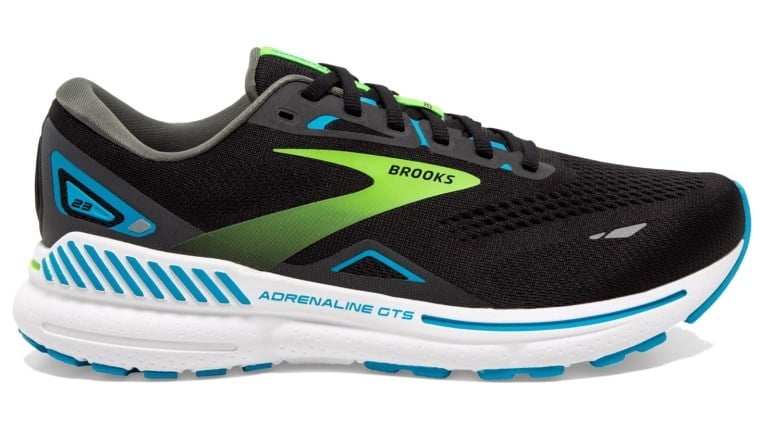
Let's jump to the midsole part of today's shoe review. Again, there’s not a lot of change. We have a 12mm offset with 24mm in the heel and 12mm in the forefoot, same in the Brooks Adrenaline GTS 23 as it was in the Brooks Adrenaline GTS 22.
The main difference is the DNA Loft v2 in the Brooks Adrenaline GTS 23 in comparison to DNA Loft technology underneath the foot in the Brooks Adrenaline GTS 22.
Why the change? DNA Loft v2 is a slightly softer compound. It's a marginal change with the overall cushioning of the Brooks Adrenaline GTS 23.
The other way to execute softness or a slightly plusher feel underneath the foot is playing around with a few different features. We have a slight cut-out on the lateral side of the midsole for heel strikers in comparison to the Brooks Adrenaline GTS 22. It's not going to be catastrophically different underneath the foot and I'd be surprised if you notice it when you're first running in these shoes.
It is going to play more of a part when the running shoe wears 100km, 200km or 300km into its life and you're noticing it to be a little softer underneath the foot on entry.
The other thing to call-out that we touched on in the intro is that this running shoe is designed for a mild overpronator.
We're up to the fourth version of the Adrenaline franchise with GuideRails, starting from the Brooks Adrenaline GTS 19. Brooks have used their BioMoGo technology on the medial side. It is a slightly firmer density of foam and it's really important to get that right because the contrast between the lateral and medial side for stability shoes over a number of years has been really important.
Dual density has been used by a number of brands and we're seeing that phased out. However, by having a slightly firmer GuideRail technology on the medial side aids in holding your foot in the appropriate stance phase through the midsection of your gait cycle.
Referring to the lateral GuideRail, it's really important to know that this starts a little bit further back. The reason they do that is to keep the heel nice and stable on entry for your heel strikers. This running shoe is designed for heel strikers, but if you happen to be a midfoot or forefoot runner and like the overall comfort of this running shoe, it's still going to be absolutely fine.
This running shoe is very successful for walkers. We have a lot of podiatry referrals for this shoe for your walking community, with that GuideRail that starts back on the lateral side helping keep your foot nice and stable.
When you walk, you make contact with your heel first, specifically the central part of the heel. When you run, you make more contact with the lateral part of your heel, so it's important to know where your entry point is whether you're walking or running in this running shoe.
As we touched on, it’s on a 12mm offset. Nothing's changed there. It's been the case now for a number of years and Brooks won't tinker with that until they play around with the density of midsole. We can't see that happening for a couple of years.
It’s a very consistent overall fit, feel and function with the Brooks Adrenaline franchise and that's what you would expect for such a popular running shoe.
The Wrap Up

In summary, there's not a lot of change between the Brooks Adrenaline GTS 23 and Brooks Adrenaline GTS 22. If anything, we have found the upper to be marginally thinner with a more improved fit in regards to the heel collar of the Brooks Adrenaline GTS 23. A little bit more memory foam improves the overall comfort of this running shoe up top.
The DNA Loft v2 is marginally softer. It’s a slight change regarding the performance of this midsole in comparison to last season. This running shoe over time will probably wear more consistently with the performance of the midsole in comparison to the Brooks Adrenaline GTS 22.
However, I don't see that to be a catastrophic change to the performance which is a good thing. This is a running shoe that's existed in today's market with consistency or continuity from one season to the next. You need to make marginal improvements and Brooks have nailed that with the midsole.
As we touched on with the outsole, it’s pretty much the same story. There’s not a lot of change. There are three components of rubber on offer, but the slight difference is that we have a little bit more coverage on the Brooks Adrenaline GTS 23 in comparison to the Brooks Adrenaline GTS 22. It's more to do with the performance of the midsole, being a little bit softer.
The other thing to touch on is that BioMoGo technology is on the medial side, exactly the same as last season. It's an important factor because this running shoe is catering to overpronators and you don't want a lot of change to the performance of the support of this running shoe.
It’s very popular and very consistent. I tip my hat to Brooks because when you have ingredients on a product and it's working you don't want to tinker with it too much.
Well done to Brooks and well done to you the running community for tuning in to this review today. If you have any questions about the Brooks Adrenaline GTS 23 in comparison to the Brooks Adrenaline GTS 22, please contact our Sportitude shoe experts.
If you want to know where this running shoe stacks up in comparison to others out there, I'll give you a couple right now. The New Balance 860, the Asics GT-2000 and even your Asics GT-4000 offer some similarities. The Mizuno Wave Inspire also comes to mind.
If you want to know a little bit more about this please let us know and we'll get back to you as soon as we possibly can.
Until next time stay kind to one another, happy running and we'll see you on the road. Take care.
FEATURES
- Support: Stability
- Upper: Engineered Air Mesh
- Midsole: Brooks DNA Loft v2
- Heel Height: 24mm
- Forefoot Height: 12mm
- Offset / Drop: 12mm
Men
- Weight: 286g / 10.08oz
- Widths: D (standard), 2E (wide), 4E (extra wide)
Women
- Weight: 258g / 9.1oz
- Widths: B (standard), D (wide), 2E (extra wide)
-
Brooks Adrenaline GTS 23 - Mens Running Shoes
-
Brooks Adrenaline GTS 23 - Mens Running Shoes
-
Brooks Adrenaline GTS 23 - Mens Running Shoes
-
Brooks Adrenaline GTS 23 - Womens Running Shoes
-
Brooks Adrenaline GTS 23 - Womens Running Shoes
-
Brooks Adrenaline GTS 23 - Womens Running Shoes
-
sold outBrooks Adrenaline GTS 23 - Womens Running Shoes
For a more in-depth shoe fitting experience, you can book a free 15 minute video chat in a Live Fit session or make an appointment to discover your RunDNA at Sportitude Running@Hindmarsh.
Follow Sportitude Running at:
Instagram: sportitude.running
If you liked this, you'll love:
What Type Of Running Shoe Is Best For Me?
What Type Of Technical Running Sock Is Right For Me?
Running Shoe Guide 1: What To Do When Your Running Shoes Arrive
Running Shoe Guide 2: How To Break In Your New Running Shoes
Running Shoe Guide 3: How To Clean And Care For Your New Running Shoes

